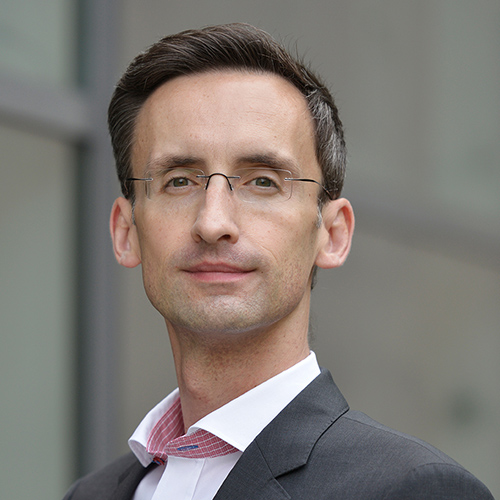Digitalization and innovation—two buzzwords that characterize all communication today. Artificial intelligence, data analytics, machine learning, wearables, drones, and robotics, to name just a few of the technological drivers. Companies are intensively engaged with modern technologies and simultaneously ask themselves the question: How can innovation and digitization be promoted on an organizational, methodical, and process-related level? Our client ÖBB also dealt intensively with this topic and founded DIGI@ttack. I met Richard Berger, co-founder and district manager for "Digital Innovations" at ÖBB-Business Competence Center (ÖBB-BCC) in Vienna, for an interview and gained extremely exciting insights.
Mr. Berger, who or what is DIGI@ttack?
We are a 13-person team that supports, drives, and implements digitization and IT-supported innovation processes in the ÖBB Group. We are often called "nerds," but I have to say that is what we are and what we want to be! 😉
"The greenfield as an opportunity!"
How did this innovation unit come about?
About two years ago, in the course of my change of role within the ÖBB Group, the opportunity arose to put the topic of "Digital Innovation" on a new footing together with my colleague Gerald Schinagl. Of course, the company had already worked on innovations in the past, but, unfortunately, many of these initiatives could not meet the needs of the customers. Why?
Such units often searched for their own topics and then developed them into something they thought made sense. Then it was presented to the specialist departments and asked: "Well, who needs it now?" As you can imagine, the demand was not particularly high. Gerald and I had the unique opportunity to redesign the team from the scratch as a greenfield, so to speak, and to introduce it to the management as a staff unit. We took this opportunity!
What approach do you take to not fail like some before you?
The starting point was an analysis of the various existing areas of innovation within ÖBB and the results of failed projects. We constantly look around the market to see what technological innovations there are. We examine where and how we can use these technologies in our company, and then we prepare them for the management. As next steps, we look for partners in the specialist areas and jointly develop proofs-of-concept (PoCs) and develop these further for commercial use or, if necessary, into a product. It is important to us not to drive innovations from technology, but always from the point of view of customers and from the point of view of the benefits to be achieved. Let's take the example of the blockchain—just because there is a blockchain does not mean that this technology brings us added value as ÖBB.
"Holistic, early, agile!"
Have you been able to identify the success factors in your approach to find the ideal solution for your customers?
In order to develop suitable solutions, it is necessary to understand the business of the subgroups that are our customers. That’s why, we involve everyone: customers— at an early stage in the innovation process, operative employees—who ensure the classic day-to-day business, and the management.
A holistic research approach is important: For example, consider that a possible solution is technically perfect and technically feasible, but that there are legal obstacles. It must be recognized early on, and it should be dealt with a conscious decision taken well in time.
Our agile process model—in which concrete results are quickly delivered in iterations and findings are divided into retrospectives—helps us to improve ourselves continuously.
There is a whole range of new organizational forms that promise better sustainability and the associated challenges: faster reaction and adaptation to new markets and technologies, more flexibility and disruptions. Which model did you choose? And, why?
We rely on holocracy and sociocracy, but we didn't know that right from the beginning. It was only when we consciously addressed it that we realized that the typical model of a leadership hierarchy was not appropriate for us. The starting point, therefore, was the question of how we want to work and what roles are required.
It was important for us to be able to address different target groups—from technically inexperienced to IT-experienced to colleagues with in-depth IT know-how. And that's how we built our team: We have several prototyping managers, but also front and backend developers as well as data scientists who accompany an idea from its creation through a prototype to the finished product. Another team member is responsible for "knowledge and information management." We want to make our experience accessible to everyone in the company.
There is the concept of minimal risk innovation. This means that innovations that are viewed and tracked should be viewed from the outset with safety glasses and from the perspective of a data protection officer. This is an omnipresent issue today; so, we have invested in another person who is concerned with security, privacy, and some architecture. That's a man in great demand; I can tell you (laughs)! And then we realized: This team has all the roles to work very independently in a self-organized fashion; hence, there is no need for hierarchical leadership.
"The first ‘leaderless’ team of ÖBB!"
How was this new approach received by the rest of the organization? Was there any resistance?
Our current organizational model is tailored to our needs and is not the holocracy or sociocracy model from the textbook. Gerald Schinagl created the first version of our so-called "constitution" which—entirely according to the agile idea—was further developed and refined in the course of time and together with the team.
In fact, we were then the first "unguided" team at ÖBB as per the decision of the Supervisory Board. However, with a small addition by the Supervisory Board: "You report to us every six months about how you are doing with it and what the challenges were. If you are successful, we will extend this organizational form to other areas as well." The latter, the application in other areas, has not yet happened, but we are already thinking intensively about which teams might be suitable for it. Of course, there are also areas where this form of the organization just doesn't fit. The whole ÖBB is agile and "without leadership." I can't imagine that!
I have already picked up the term "agile" several times in our conversation. How do you focus on agility across the team as well as across the ÖBB group?
ÖBB's culture is getting better and better when it comes to agility and agile implementation. There are some subdivisions and subgroups within ÖBB that use agile methods in different depths. Admittedly, it is a major cultural change—especially for those in need—because the concept of agility also requires that you have a product owner on the customer's side who knows exactly what his responsibility is.
This is still one of the biggest challenges for us to support our clients tell us exactly and iteratively what they need and whether what we produce is what they want at the end of the day. We mainly work with scrum, but we have also used lean management. Especially with an autonomously organized model like ours, which requires a lot of self-organization, you can't avoid agile ways of working.
"We were naive at first!"
Is there any learning from the last two years since DIGI@ttack was founded that you would like to share with other companies which wish to move in the same direction?
It makes sense to have a plan that is written down and well-communicated to all involved. Not just jumping on the bandwagon in the sense of “We're working agilely and without leadership now because it's cool right now.” The person, the team, and the personal responsibility—not everyone can deal with them equally well. If you want it to work for the whole team, you have to pick up exactly the people who have problems in both directions. Personal responsibility doesn't mean that I can do what I want. That's just as bad as wanting instructions for everything.
We've already had to deal with both of them in the team. At the end of the day, there is no classical style of leadership. But, you can't also give in to the illusion that it just works. By definition, we didn't originally have that either. In the beginning, we naively assumed that the team would take care of everything itself. That doesn't work. You have to name someone in the team, be it a group or a person, who feels committed to the topic of the further development of the unit and who also bears and assumes this responsibility.
What are your next steps? Or, are you in a steady state that doesn't require much interaction?
Let's say it this way: If we had taken on our original task from the beginning, namely to work innovatively and on the subject of digitization, then I would say that our team is already very good. But what has come out is that we—I don't mean necessarily—should make money, but we should reasonably make money. In the beginning, we had the privilege of being exclusively innovative and not having to be profitable. But that is not good for our external image because other areas do not have this freedom. That generates envy, which is not good. As a result, we are now also selling our services. But that leads to another problem, namely that we as human beings cannot necessarily switch so quickly. So, if we have to sell something on the one hand and be very innovative on the other, then these are different role models. We are currently in the process of repositioning ourselves.
To colleagues from outside and colleagues within the ÖBB Group, we would like to offer the opportunity to come to us with a topic and work with us for a certain period of time. Here, however, we still have to find out the possibilities under labor law.
"To bury your head in the sand is not an option for us!"
Allow me a personal question: How do you actually generate ideas?
One thing is always very important to me: lateral thinking! Phrases like “You can't do that because ...” or “Yes, but ...” you hear often enough. I know what I'm talking about; I've often experienced it in my 30 years with ÖBB and often caught myself doing it. Nevertheless, you have to constantly question things and you can't take them for granted. Let me give you an example: Although autonomous driving is not our primary topic at the moment, we are already working on some areas of it, even though the legal framework does not allow it. Doing nothing and burying our heads in the sand is not an option for us because the subject will come sooner or later and the laws will have to adapt accordingly.
We can, therefore, look forward to seeing what the future holds in store for us all. Thank you very much for the exciting interview, Mr. Berger.
More info about DIGI@ttack: https://bcc.oebb.at/de/innovationen




